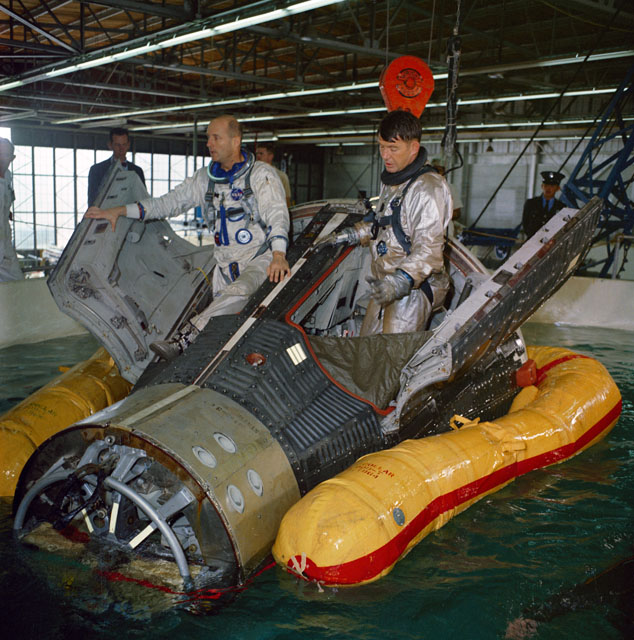
Almost 50 years ago, the United States almost staged its first rendezvous mission between unpiloted and piloted vehicles in low-Earth orbit. An Atlas-Agena target craft was almost successfully launched, yet failed to achieve orbit, and two astronauts—Gemini VI crewmen Wally Schirra and Tom Stafford—almost followed it on a voyage which might have pushed America far ahead of the Soviet Union in the race to plant human bootprints on the Moon before the end of the decade.
Almost.
The loss of the Atlas-Agena, as described in yesterday’s AmericaSpace history article, was a potential show-stopper for Project Gemini, for the target vehicle would play a critical role in its ability to perform rendezvous, docking, station-keeping, and orbit-raising exercises. All of these objectives, as well as spacewalking and long-duration flight, needed to be perfected if the late President John F. Kennedy’s goal of reaching the Moon by the end of the decade was to be achieved.
A new Agena would not be ready until early 1966, but a perfect alternative lay on the horizon. Immediately after the Agena’s loss, Gemini VII crewman Frank Borman overheard a conversation between McDonnell officials Walter Burke and John Yardley: the former suggested launching Gemini VII as Schirra and Stafford’s “new” docking target. A study of sending Geminis up in quick succession had been done months earlier and seemed ideal, but for one thing. Burke sketched his idea onto the back of an envelope, but Borman doubted the practicality of installing an inflatable cone onto the end of Gemini VII to permit a physical docking. Several senior NASA managers, including George Mueller and Charles Mathews, dismissed the entire idea, since it would require the launch of both Geminis within an unacceptably tight two-week period.
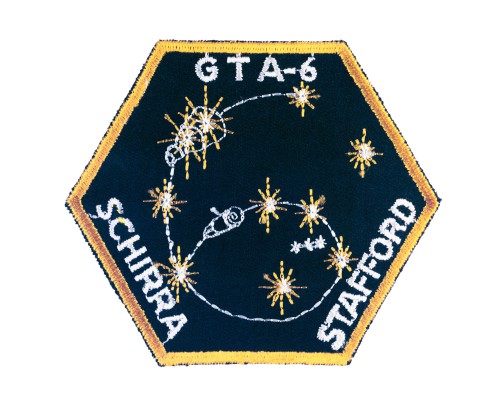
Others thought it could be done. Joseph Verlander and Jack Albert proposed stacking a Titan II and placing it into storage until another had been assembled. The Titan’s engine contractor, Aerojet-General, had stipulated that the vehicle must remain upright, but this could be achieved and the rocket kept on the Cape’s disused Pad 20. Immediately after the first Gemini’s launch from Pad 19, the second Titan could be moved into position and sent aloft within a week. The plan, however, held little appeal and received little enthusiasm, with most attention focused on swapping the lighter Gemini VI for the heavier Gemini VII, thereby making good of a bad situation by using the Titan II already on the pad to fly Borman and Jim Lovell’s 14-day mission.
Over the following days, as this was discussed in the higher echelons of NASA management, it became evident that if the two spacecraft were swapped, the earliest that Borman and Lovell could be launched would be 3 December 1965. However, if the Gemini VII spacecraft was too heavy for Gemini VI’s Titan, a delay until around 8 December would become necessary to erect the more powerful Gemini VII Titan. It was then envisaged to launch Schirra and Stafford on their rendezvous mission with another Agena sometime in February or early March 1966.
As these plans crystallized, Burke and Yardley formally suggested their joint-flight idea to senior NASA officials, who found few technical obstacles, with the exception that the Gemini tracking network might struggle to handle two missions simultaneously. At first, Flight Director Chris Kraft thought they were out of their minds, but after consulting his control team and Deke Slayton, head of Flight Crew Operations, relented. The prospects for Burke and Yardley’s plan steadily brightened when it became clear that the heavy Gemini VII—which, after all, was intended to support a mission seven times longer than Gemini VI—could not be lofted into orbit by Schirra and Stafford’s Titan: the booster lacked the necessary impulse. Yet the question of tracking two vehicles at the same time remained.
Then, another possibility was aired. Could the tracking network handle the joint mission if Gemini VII were regarded as a “passive” target for Gemini VI? Borman and Lovell would launch first and control of their flight would proceed normally as Gemini VI was prepared to fly. Then, as soon as controllers were sure that Gemini VII was operating satisfactorily, they would turn their attention to launching Gemini VI; in the meantime, Borman and Lovell’s flight would be treated like a Mercury mission, wrote Deke Slayton, “where the telemetry came to Mission Control by teletype, letting the active rendezvous craft have the real-time channels that were available.” This mode would continue until “Gemini VI-A”—renamed to distinguish it from the original Agena-based mission—had completed its tasks and returned to Earth. After Schirra and Stafford’s splashdown, Borman and Lovell would again become the focus of the tracking network.
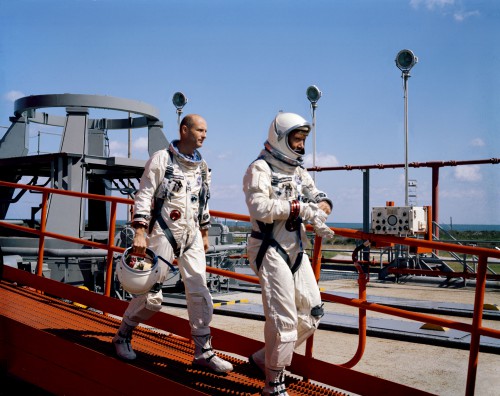
Before NASA Headquarters in Washington, D.C., had even come to a decision, the rumor mill had already informed the press, some of whom reported the possibility of a dual-Gemini spectacular. On 27 October, NASA Administrator Jim Webb and his senior staff discussed the idea and issued a proposal for the joint flight to the White House. He informed President Lyndon B. Johnson that, barring serious damage to Pad 19 after the Gemini VII launch, Schirra and Stafford’s Titan could be flown within days to rendezvous with Borman and Lovell. Johnson, residing at his ranch in Austin, Texas, approved the plan on 28 October, and his press secretary announced it would fly in January 1966. At NASA, however, December 1965 was considered more desirable.
As October turned to November, preparations gathered pace. Gemini VI-A’s Titan was destacked and placed in bonded storage under plastic covers, and the heavy-lift Titan for Gemini VII was erected in its place. Pad Leader Guenter Wendt’s first reaction when he saw the short, nine-day Gemini VI-A pad schedule was “Oh, man, you are crazy!” Although Schirra and Stafford’s mission would essentially not change, that of Borman and Lovell was slightly adjusted to circularize its orbit and mimic the Agena’s flight path as closely as possible. Yet their own mission was fraught with great risk.
Since their assignment to Gemini VII, Borman and Lovell had been intensely focused on their primary objective: to spend 14 days (330 hours) in space, thereby demonstrating that astronauts could physically and psychologically withstand a maximum-length trip to the Moon and back. The results from the two previous long-duration flights, Gemini IV and Gemini V, had been mixed. Jim McDivitt and Ed White had returned fatigued after four days, while Gordo Cooper and Charles “Pete” Conrad had hardly enjoyed their eight days sitting in an area the size of the front seat of a Volkswagen Beetle. Sleeping in shifts of four or five hours apiece had proven impractical, Borman and Lovell learned, so they resolved to sleep and work together. Moreover, they felt that their “work” time would not benefit from a rigid plan, opting instead for a broader outline which they could adapt in orbit.
At 2:30 p.m. EST on 4 December 1965, Gemini VII roared into orbit. “We’re on our way, Frank!” yelled Lovell as the Titan rolled and pitched in its ascent trajectory, achieving orbit five and a half minutes later. After a station-keeping exercise with the Titan, they settled down to eight days of experiments, ahead of the launch of Gemini VI-A and the rendezvous.
As the flight wore on, conditions became increasingly less comfortable, with both men complaining of stuffy noses and burning eyes. The cabin, Borman reported, was too warm. Removing their suits helped, yet even that had been a matter of some debate on the ground. Days earlier, on 29 November, Bob Gilruth had requested approval from NASA Headquarters for the astronauts to remove their suits after the second sleep period and only don them at critical junctures, such as rendezvous and re-entry. By the time Gemini VII launched, the plan had been amended slightly: one of them had to be suited at all times, but the other could remove his garment for up to 24 hours. Both men, however, had to be fully-suited for rendezvous and re-entry. Still, the intense discomfort was there and, as the mission wore on with no major issues, the rationale behind the one-suit-on/one-suit-off decision became unsupportable.
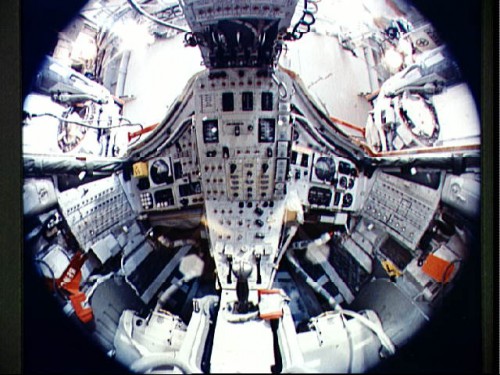
Even with his suit unzipped and gloves off Borman sweated heavily, while the unsuited Lovell remained dry. After 24 hours, Lovell asked to sleep unsuited, to which Borman agreed, despite his own discomfort. Lovell, the larger of the two, had more difficulty getting out of his suit in the confined cabin and, although he donned some lightweight flight coveralls for a few minutes, he removed them just as quickly, due to the intense warmth.
After four days of this torment, Borman asked the flight controller on the Coastal Sentry Quebec tracking ship to ask Chris Kraft about the chances of both men taking off their suits. Capcom Gene Cernan discussed the request, firstly, with Deke Slayton, before approaching Kraft, but there was little option but to ask Lovell to put his suit back on so that Borman could remove his suit. Concern was mounting, however, about how alert the astronauts would be for the Gemini VI-A rendezvous if they were so hot and uncomfortable. Bob Gilruth, head of the Manned Spacecraft Center (MSC) in Houston, Texas, certainly favored both men having their suits off at the same time. Also, NASA flight surgeon Chuck Berry, looking at the biomedical data, saw clear signs that blood pressures and pulse rates were closer to normal when Borman and Lovell were unsuited. Eventually, on 12 December—the very day that Schirra and Stafford were due to fly—NASA Headquarters finally agreed to allow the Gemini VII crew to remove their uncomfortable suits.
The astronauts’ patience was, however, tried on a number of occasions, most notably when a urine bag broke in Borman’s hands. “Before or after?” asked Chuck Berry. When Borman affirmed it was after, Berry replied “Sorry about that, chief.” After the flight, Lovell would describe their living and working conditions in a similar manner to Cooper and Conrad: like sitting in a men’s toilet for a fortnight without access to a shower. This did not bode well for the physicians. After splashdown, one of their tasks was to examine calcium loss in space, and they would be obliged to not only sift through Borman and Lovell’s liquid and solid waste, but also microscopically analyse the contents of their underwear. …
In the meantime, Wally Schirra and Tom Stafford’s Gemini VI-A Titan had been raised on Pad 19 on 5 December. A computer problem quashed hopes to launch on the 11th, but the prospects were bright for a second attempt the next day. Launch was scheduled for six seconds past 9:54 a.m., and the countdown clock ticked perfectly toward an on-time liftoff. Precisely on cue, the Titan’s first-stage engines ignited with a high-pitched whine.
Then, after less than 1.2 seconds, they shut down.
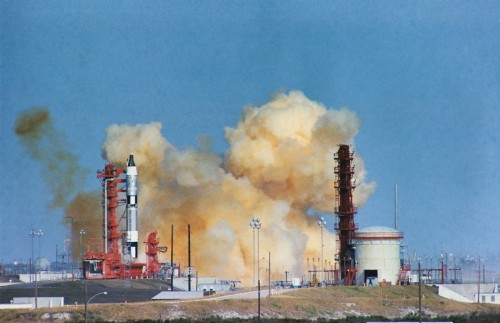
Instantly, Schirra, his hand clasping the D-handle to fire their ejection seats, faced a life-or-death decision. The mission clock on the instrument panel had started running—as it would in response to the vehicle lifting off—but he could feel no movement. If the Titan had climbed even a few inches, there was a very real risk that its full load of volatile propellants could explode in a holocaust. In his autobiography, We Have Capture, Stafford remembered vividly the moment that the behemoth came alive and, just as vividly, the instant at which its roar ceased. “The sound of the engines died even though the clock started and the computer light came on, both indications that we had lifted off,” he wrote. “But I could feel that we hadn’t moved. More important, there was no word from [Capcom] Al Bean confirming liftoff, which was critical.” In fact, it was the feeling of stillness that convinced Schirra not to risk ejecting.
Kenneth Hecht, head of the Gemini escape and recovery office, was surprised that he did not eject, but in reality, neither Schirra nor Stafford had much confidence in the seats and instinctively desired to remain with their “bird” as long as possible. Stafford felt that the 20-G acceleration of an ejection would have left him with, at best, a cricked neck for months. Moreover, there was a very real risk of death.
Yet Schirra would not have put them in any undue danger. “If that booster was about to blow,” he said, “if we really had a liftoff and settled back on the pad, there was no choice. It’s death or the ejection seat.”
It was the latest near-disaster in a string of unfortunate events which befell Gemini VI-A. Three days later, on 15 December 1965, Schirra and Stafford rode perfectly into orbit and completed a highly successful rendezvous with Gemini VII and Borman and Lovell. Their triumph overcame a fundamental hurdle which lay on the road to the Moon and enabled the bolder steps of rendezvous, docking, and integrated spacewalking which followed. After so many “almosts,” Gemini VI-A had brought the first human bootprints on the lunar surface another step closer.
This is part of a series of history articles, which will appear each weekend, barring any major news stories. Next week’s article will focus on the 20th anniversary of STS-66, a multi-faced shuttle science mission which explored the workings of Earth’s atmosphere and climate.
Want to keep up-to-date with all things space? Be sure to “Like” AmericaSpace on Facebook and follow us on Twitter: @AmericaSpace




Interesting articles that clearly mark the turning point in the US/Soviet race to the moon. No doubt the Russians knew it was over and the first human would be American.